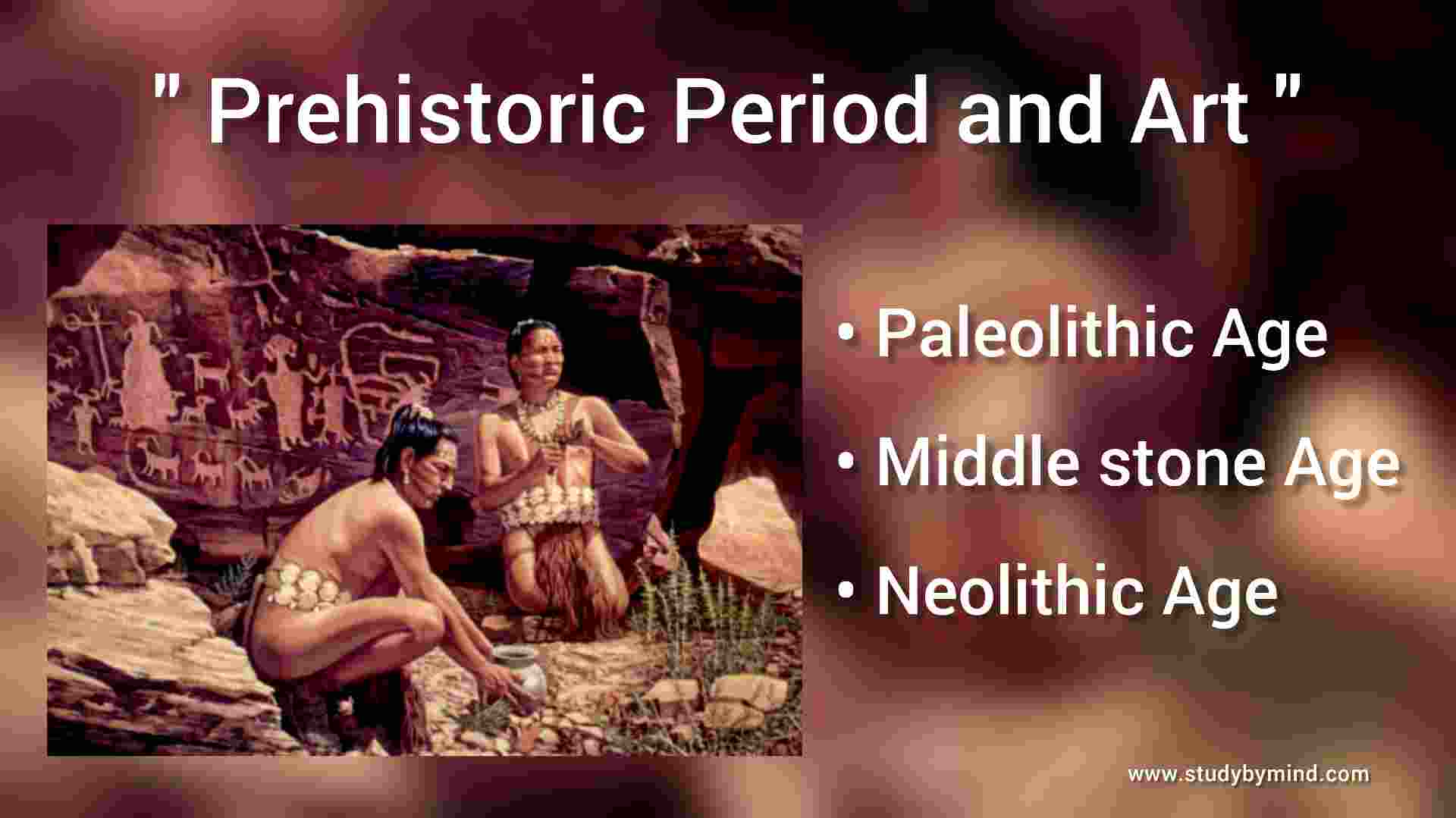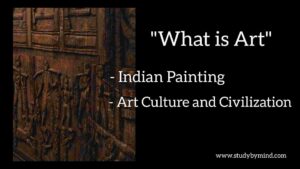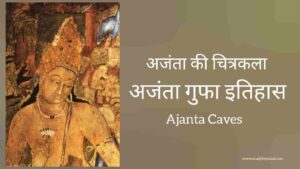Art Description
The history of painting is said to be as old as the history of man. ” Prehistoric Period and Art ” Painting is to give an impression of a form by marking the length, width, roundness and height with the help of colors and lines on a flat surface like wall, wood, plank etc. The word “art” is that important part of culture which makes the human mind beautiful, beautiful and orderly. Religious and philosophical beliefs have been expressed in a simple way in Indian art. According to ancient Indian texts, the importance of art has been told – Dharma, Kama, Artha and Moksha are attained only through art. Similarly, in India, art has been considered as a means for important life, not ‘art for art’. Prehistoric Period Notes .
प्रागैतिहासिक काल तथा कला in Hindi – “ Click here “

Prehistoric Period and Art
We’ll tell you about prehistoric art here. Man saw his helpless condition after taking birth on earth. His negligible consciousness was awakened near the great forces of nature and he made many protective efforts to pacify his stomach’s hunger, to keep his body safe from cold, heat and rain and to protect himself from the fierce animals. He made stone tools and weapons during this period (about 6 lakh years BC). With which he could hunt and fill their stomach and also protect his body. After this, even after thousands of years, he later took refuge in caves for safety in this sequence. He lived his life in tender feelings experiencing the speed of hunting and the beautiful image of animals. To whom he painted caves and hard walls of rocks or flat rocks with paintbrush and tank or sharp stone But engraved it. In this way he immortalized the sweet and happy moments of his life, and that picture is very famous even today. He lived in the cave and the Kandrao, then he burned animal fat and wood to warm and illuminate the Kandrao. He made a simple and succinct expression of his life in the dim light inside these caves by drawing pictures on the rough walls and floors of the caves through paintbrush. The man of that time used exclusively stone, wood and clay. For this reason, scholars have also called this period by the name of “Stone Age”. What is meant by prehistoric Period .
Three Parts of Prehistoric Period
The prehistoric period can be divided into three parts, they are as follows –
- Pre-Stone Age( Paleolithic Age)
- Middle Stone Age(Middle Stone Age )
- Neolithic Age
Pre-Stone Age or Complete Stone Age ( Paleolithic Age or Mesolithic Age) from 30,000 BC to 25,000 BC.
The remains of this era are found especially in the form of tools and weapons etc. Some of which are of strange and unsightly shape. Most of these ancient remains have been found along with the erupted bones of animals. Very few remains of this era have been found in India. And whatever examples are available, those rights have been received from the regions of southern India. It is said that southern India is the oldest part of the country. The man of this time has been called by the name of Quartzite Man. Scholars have considered this era as 30000 to 25000 years BC. And the examples of pre-Stone Age painting have not yet been found in India.
Middle Stone Age or Mesolithic Age from 25,000 BC to 10,000 BC.
Very few materials have been found for this time. Humans of this time have used the same stone as humans of complete stone epoch or Pre-Stone Age . In this era, almost all the work has been done similar to the earlier stone age. And most everything remains the same.
Neolithic Age from 10,000 BC to 5,000 BC or 3,000 BC.
Very few remains of this era have been found. Most of the examples that have been found have been found around Bellary. A circular instrument made of stone of this era has also been found from the valley of the Narmada river. And along with this, the excavated bones of hippopotamus and other animals have been found in the Narmada valley. An ancient instrument of this type has also been found from the valley of Godavari river. Remains of ancient art have been found in Bundelkhand, Assam (Assam) and Nagpur hills, Mirzapur, Ghazipur and Kaimur mountain ranges of Vindhyachal. East Stone Age humans were confined to the area of Cudapa and Madras City (Chennai). But the man of Last Stone Age spread all over India and Bellary remained its main center. Industries of this time for making machines and tools have been found in southern India. And the man of this period also used to polish stone tools and tools, and used clay pots made on chalk. Hironji pieces, seals and stones have been found at some places. On which Hironji was grinded. This proves that Hironji was used as a colour. In Bellary and many other places, paintings have been made by digging stones and lines. The man of the Late Stone Age used painting for the first time and even today the examples of his painting are preserved in various places. And that picture is very famous even today.
Examples of Late Stone Age painting have been found in India
Beautiful and interesting examples have been found in many places of painting of the Late Stone Age in India. In these examples, there is not only the knowledge of the development sequence of the ancient painting, but apart from this, the life of the primitive man is also thrown light. The prominent examples of painting of this era are Bellary, Binad-Edkal, Hoshangabad, Singhanpur, Bundelkhand, and Baghelkhand (Vindhyachal), Mirzapur, Raigad, Harniharan, Billasrangam, Budhar, Pargana, Manikapur, Pachmarhi, Bihar, Bhimbetka, Banda, Gwalior, Mandsaur. , Bhopal region etc. are found in places.

Purpose of Prehistoric Paintings
Stone Age humans created these paintings in order to preserve the memory of the environment around them and to express the history of their conquests. Cave-dwelling humans created most of the paintings because of their tendency to embody their abstract spirit, which also includes witchcraft etc. Basically, all these attitudes are the motivators for the progress of the entire human race. The daily life of primitive man is visible in these pictures. Drawing a picture of a primitive hunter-gatherer animal before hunting And by doing some witchcraft on him, believed in the success of his hunting. He believed that the animal which he used to depict in the form of a picture, it easily came under his control. Most of such pictures have been found in which animals tied with arrows, spears or spears have been depicted. In this time, eating after killing an animal and then doing dance and singing etc. with glee was the routine of man. And all this is visible in the paintings of the Late Stone Age. The cave dwelling man worshiped the invisible powers for his success – swastika, hexagon, numbers and lines etc. Sorcery through many symbols – Started as a trick. What is the subject of prehistoric art .
Features and basic tendencies of paintings of prehistoric art
- The Law of Pictures of the Period – All illustrations of paintings of prehistoric times are made of red, black or yellow and white colors. These paintings have been made in rock walls, cave floors, reefs or ceilings. Many pictures have also been inscribed on the stone stones. These paintings are made on rough walls of rocks by mixing red (ocher or hironji), black (coal, kajal or soot), or white (khadiya) colors mixed with animal fat. In these pictures the line or border line is dominant. For this reason, they can be considered as line drawings. And the boundary lines of the figure are mostly carved with a sharp stone. So that it does not get mixed with rain water, and remains permanent. Generally human figures have been made by 2-3 lines, and sometimes human figures have been made with a framed torso. In which some oblique and sometimes some lying lines have been filled. Many such images have been created.

- Color and Size – The color used in these pictures is based on the child-friendly nature. The colors have been applied flat on the surface to fill the shape. Easily available mineral colors have been used in these paintings. Most of the colors used in these colors are Ocher, Hirouji, Ramraj and Khadiya. In addition to these colours, coal or kajal has been used in chemical colours. In the construction of most of the figures, straight lines, curves and rectangles etc sizes have been used. Many shapes have been used, including swastika, triangle, circle, hexagon and rectangle. And these shapes have expressed various forces of nature or witchcraft beliefs, and are mostly made by lines of pictures. Otherwise, the Stencil method has been used completely. This painting is rough and harsh, but there’s life in it. The painter used to make his paintbrush by grinding one end of any fibrous wood, bamboo or hell etc. Primitive painters used the bone of the hindquarters of animals as a cup to mix colors with animal fat. The simplicity, ease and subtle drawing method of all these paintings is a great inspiration for today’s artist.
FAQ – Prehistoric Period
Q . What is meant by prehistoric period?
A. Prehistoric period means the history of millions of years ago. Stone Age – Prehistoric period.
Q. How many periods of prehistoric period are there?
A. There are three periods of prehistoric period-
Paleolithic Age
Middle Stone Age
Neolithuc Age
Q . What is prehistoric painting?
A. Art and painting of hunting and hunting many millions of years ago.
Q. What is the true meaning of the word prehistoric?
A. Prehistoric period means the history of millions of years ago. Stone Age – Prehistoric times.
Q. What is characteristic of prehistoric paintings?
A. All pictures of paintings from prehistoric times Examples are made of red, black or yellow and white. These paintings have been made in rock walls, cave floors, reefs or ceilings. Mostly the colors of Ocher, Hirouji, Ramraj and Khadiya have been used.
Q. Where are the prehistoric paintings found?
A. The prominent examples of painting of this era are Bellary, Binad-Edkal, Hoshangabad, Singhanpur, Bundelkhand, and Baghelkhand (Vindhyachal), Mirzapur, Raigad, Harniharan, Billasrangam, Budhar, Pargana, Manikapur, Pachmarhi, Bihar, Bhimbetka, Banda, Gwalior, Mandsaur. , Bhopal region etc. are found in places.
Q. How many parts is history divided?
A. History is divided into three parts – Ancient History, Medieval History, Modern History.
Q. Which are the three parts of period?
A. Prehistoric period, Vedic period, pre-Buddhist period.
See also
- More About Prehistoric period – “ Click here “
- Primordial Ancient Painting – Painting of Cavities, Kandrao, Rocks – ” Click here “
- Art History – What is Art? – “ Click here “
- History of Evolution of Organisms – “ Click here “



